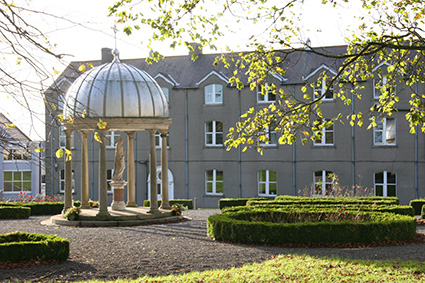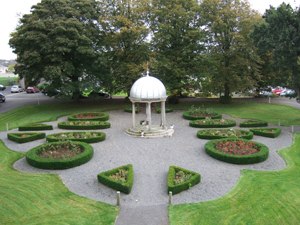Our story begins in 1807 when Daniel Delany, Bishop of Kildare and Leighlin, Ireland, invited six women to form a religious community in Tullow, Co Carlow on the first of February. He named them the Sisters of St.Brigid, after the great 5th century Saint of Kildare. A year later, 1808, he also founded a community of men and named them the Brothers of St. Patrick or Patricians.
Ireland was still in the shadow of the penal laws. There was a great need for education particularly in religious faith. Daniel Delany experienced the full force of these laws growing up in a Catholic family in the mid-1700s. Catholics were denied human and religious freedom. Catholic schools were outlawed. Severe penalties were inflicted on Catholic parents who attempted to procure Catholic education for their children at home or abroad.
Early History of Brigidines
Religious Congregations come into being through the charismatic experience of founders who feel impelled to give themselves to God and God’s work, almost always in response to some historical pressing need. It was in answer to the anguished cry of a deeply wounded Ireland that the Brigidine Congregation was founded by Bishop Delany. The Penal Laws of the 18th century had wrought what seemed irreparable havoc on the once far-famed “Land of Saints and Scholars,” leaving Ireland’s oppressed and largely pauperised people bereft of their proud Gaelic culture. The people of Ireland were deprived of a much treasured education tradition. They were reduced to an underground practice of their faith.
Daniel Delany was a curate in Tullow during the episcopacy of Dr. O’Keeffe, Bishop of Kildare and Leighlin. At that time the Bishop resided in Tullow. The penal laws, when in operation, placed many impediments to the exercise of ‘Divine Worship on the Sabbath day,’ and so religion was in a depressed state in the country. Fr. Delany felt that “more sin was committed on the Sunday than during the entire week, as it was spent by the greater number of people at public dances, card playing, cock fighting and drinking.”
“He decided to turn his attention to the youth of the parish and introduced Sunday school in the Chapel in Tullow about 1777. This was for the purpose of teaching children their Catechism.”
As a curate, Dr. Delany tried every method he could devise to prevent this behaviour, but found them ineffectual. He then decided to turn his attention to the youth of the parish and introduced Sunday school in the chapel in Tullow about 1777. This was for the purpose of teaching children their catechism. He began by forming a choir and as the young people collected to sing hymns, he appointed some pious women to teach them their prayers and catechism. As the numbers increased, many of these same children began to withdraw from public amusements. In a short time the numbers had so increased that there were an insufficient number of teachers for his classes.
Adapted from Early History of the Brigidines, by Sr. Mary O’Riordan csb and From the Acorn to the Oak (2010) by Sr. Rita Minehan csb.
Find out more about the history of the Brigidines, download From the Acorn to the Oak.
Sunday Schools
When Daniel Delany became a Bishop in 1783, he established the Confraternity of the Blessed Sacrament in Tullow parish in 1785. In time, the members began to teach the catechism. Next, he formed reading schools on Sundays and by degrees adults joined these Sunday Schools. This meant that Sundays were spent in pious practices and subsequently the numbers taking part in various ‘amusements’ decreased. He also deplored the state of his native parish of Mountrath and, hearing complaints from successive Curates appointed there, he prayed for direction as to his future action. Eventually he sent six pious young women to Mountrath where they remained nine months. During this time the Sunday Schools were established and (according to the annals) ‘good morals went on improving in the parish.’
Realising the difficulty of keeping the schools supplied with teachers, he hoped to persuade the Presentation Sisters to come to his assistance, but they were unable to help. Besides, the Presentations were founded to teach the poor.
Daniel Delaney wished to teach rich and poor alike … “he had long desired to establish schools where all the children, rich and poor of the parish could be taught.”
First Brigidine Convents
He decided to found a new religious order to carry out this work. With much prayer and having overcome many difficulties, he was determined to establish the convents in the two parishes, Tullow and Mountrath. Since the Sunday Schools took place in the chapel he wished to have convents convenient to them.
He ran into difficulties in this endeavour, as the lands in both Tullow and Mountrath were owned by landlords who were averse to giving leases forever or for the purposes of ‘erecting a Catholic Chapel.’ Because of this, the first Chapel in Mountrath stood on a sand bank. As always in a crisis situation, Dr. Delany exposed the Blessed Sacrament for adoration in Tullow for the intention of solving the problem. Fortuitously, Mr Hawksworth, an agent of Lord Castlecoote, and his very charitable wife, gave Dr. Delany a plot of ground. Through Hawksworth’s influence the lease was secured forever. The chapel of Mountrath was commenced in 1795. However, the Irish Rebellion in 1798 meant that he had to give up the intention of founding the convents until 1807.
Shortly after the 1798 Rebellion, Dr. Delany’s faith was evident again when he took the present chapel ground in Tullow without a lease and erected the chapel and also a small house – now part of the convent. He later acquired a field adjoining this house, on which stands the present convent.
At the same time, he obtained a row of houses in Mountrath joining the chapel grounds. (These he got in perpetuity). Relying on God alone, he decided to commence a foundation in Tullow, although he had only obtained a promise of a lease there.
The temple and oak tree in Tullow convent grounds where Daniel Delany held processions in honour of the Blessed Sacrament.
The Annals tell us that, “he determined to put the new Institute under the special protection of the Blessed Virgin Mary, Mother of God and the glorious St. Brigid,
Patroness of Ireland and Titular of the Diocese.”
Brigidines Among the People
In a dramatic move for the time, he decided that the Sisters would not have their private chaplain because the Sisters would ‘be obliged by their Institute to mingle with the people for their instruction in the parish chapel on Sundays and holidays, he thought it better that they should hear the same Mass, which the people attended.’
In this way he felt that they would benefit the people more by being accommodating themselves to the people’s time. The same proved true for daily Mass, so that the people for whom the Sisters laboured on Sundays and holidays might have the benefit of daily Mass with the Religious.
When it came to choosing those women who would form the nucleus of the Brigidine Congregation, he looked to those who had shown a deep desire of ‘attaining perfection’ and who had already been practising an austere lifestyle.
First Six Brigidines
On 1st February 1807, La Fheile Bride, St. Brigid’s Day, six women gathered in Tullow as they responded to a personal call to join Daniel in this divinely-inspired endeavour. They were Eleanor Tallon, Bridget Brien, Judith Whelan, Margaret Kinsella, Eleanor Dawson and Catherine Doyle – all were natives of Tullow and the surrounding parishes of Ardattin and Clonmore.
They were members of both confraternities and were trained as catechists by Daniel in his Sunday Schools. He named them the Sisters of St. Brigid. He insisted that he was not founding a new congregation but rather re-founding the Order of St. Brigid of Kildare which had existed in Ireland from the fifth to the sixteenth century until the monasteries were suppressed in that century.
These women had taken permanent vows of chastity some years before 1807. They ranged in age from twenty-five to forty-eight. Daniel Delany was waiting to greet them that morning and to welcome them to the simple house he had prepared for them. He blessed the house, celebrated Mass, gave Benediction and then withdrew. They had spent almost the whole of the preceding day and night in prayer. Bishop Delany chose St. Brigid as the patroness of the congregation, thereby linking it to the spiritual heritage of St. Brigid, Patroness of Ireland.
Within three years the Bishop introduced extra teaching hours for two reasons: to give an opportunity to the married women and others who wished to attend the Sisters’ schools, and to accommodate the numbers wishing to attend the classes. In Mountrath, ‘the Sisters’ schedule was adapted to the needs of the children in their care and they have continued to do so ever since.’
By 1812, Daniel Delany was prepared to continue primary education to a more advanced stage.



